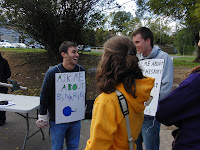The Department of Physics and Astronomy is nominating Dr. Chodrow for the College of Science and Mathematics Teaching Award. Please send an e-mail to Dr. Scully (scullyst@jmu.edu) telling why you think Dr. Chodrow deserves this award. How did having him for mechanics (or other courses) change your life, your career path, your understanding of physics? Time is short. Get your e-mail to Dr. Scully by November 1.
This is your chance to thank him for that mental kick he gave you to start you on the path to success. Help us help him get the recognition he deserves.
Tuesday, October 25, 2011
Tuesday, October 04, 2011
3 Astronomers Share the 2011 Nobel Prize in Physics!
This morning 3 American astronomers received the call of a lifetime when they were notified by the Nobel committee that they would share the 2011 Nobel Prize in Physics!
Prof. Adam Riess of The John Hopkins University/Space Telescope Science Institute, Prof. Saul Perlmutter of the Lawrence Berkeley National Laboratory/UC Berkeley and Prof. Brian Schmidt, an American now working at the Australian National University, were recognized “for the discovery of the accelerating expansion of the universe through observations of distant supernovae.”
In the 1920s, Edwin Hubble discovered that the Universe is expanding. He found that the further a galaxy is from us, the faster it moves away. If you play this movie backwards, it provides an independent piece of evidence that there was a Big Bang. Today, these 3 astronomers are being recognized for their 1998 discovery that the expansion of the universe is actually accelerating and not linear like Hubble discovered. This accelerating expansion is being driven by a mysterious force called "Dark Energy" about which little is known except that it makes up ~70% of the Universe! The group that discovers what Dark Energy actually is will likely also win the Nobel Prize in Physics.
That these 3 astronomers won the Nobel Prize for their work is not surprising since it was recognized immediately after publication that their result has a profound significance on our understanding regarding the evolution of our Universe. Indeed, both teams shared the 2007 Peter Gruber Foundation Cosmology Prize -- a gold medal and $500,000 -- and Science magazine dubbed their work as "The Breakthrough Discovery of the Year" in 1998.
Congratulations gentlemen on a very well-deserved honor!
Sunday, October 02, 2011
We took the Astronomy at the Market, literally.
 One astro faculty and a group of astro students (you'll see exactly which ones soon) took the department's Coronado solar telescope at the Harrisonburg Farmers Market. Along with the telescope, they also sported asunspotter, also to catch the Sun of course, just a little bit differently, in a clearly safe and simple way. The group also "cooked" edible comets (tasting suspiciously like ice cream), and showed how they can form their tails when the future eater pretends to be the Sun and blows a bit of "solar" wind on them.
One astro faculty and a group of astro students (you'll see exactly which ones soon) took the department's Coronado solar telescope at the Harrisonburg Farmers Market. Along with the telescope, they also sported asunspotter, also to catch the Sun of course, just a little bit differently, in a clearly safe and simple way. The group also "cooked" edible comets (tasting suspiciously like ice cream), and showed how they can form their tails when the future eater pretends to be the Sun and blows a bit of "solar" wind on them.The kids enjoyed probing cratering on potential planets' surfaces with a variety of impactors (i.e., peebles). Imagine all these while we all talked a lot about astronomy:
The black holes were surely a hit, mainly because Nathan DiDomenico was there to answer the questions:


Kyle Eskridge mastered the Sun:



Jimmy Corcoran went extragalactic:
Anthony Saikin delighted audience with details about binary stars:

Emil Christensen illuminated on the history of astronomy, geo- vs helio-centric systems, telescopes, distances to stars, etc…

Anca Constantin featured the big bang and the history of the universe:

You can see here many more pictures with us and the curious people who surrounded us on that first day of October (also our 1st, and thus our debut with the "Astronomy at the Market" Show).
Subscribe to:
Posts (Atom)